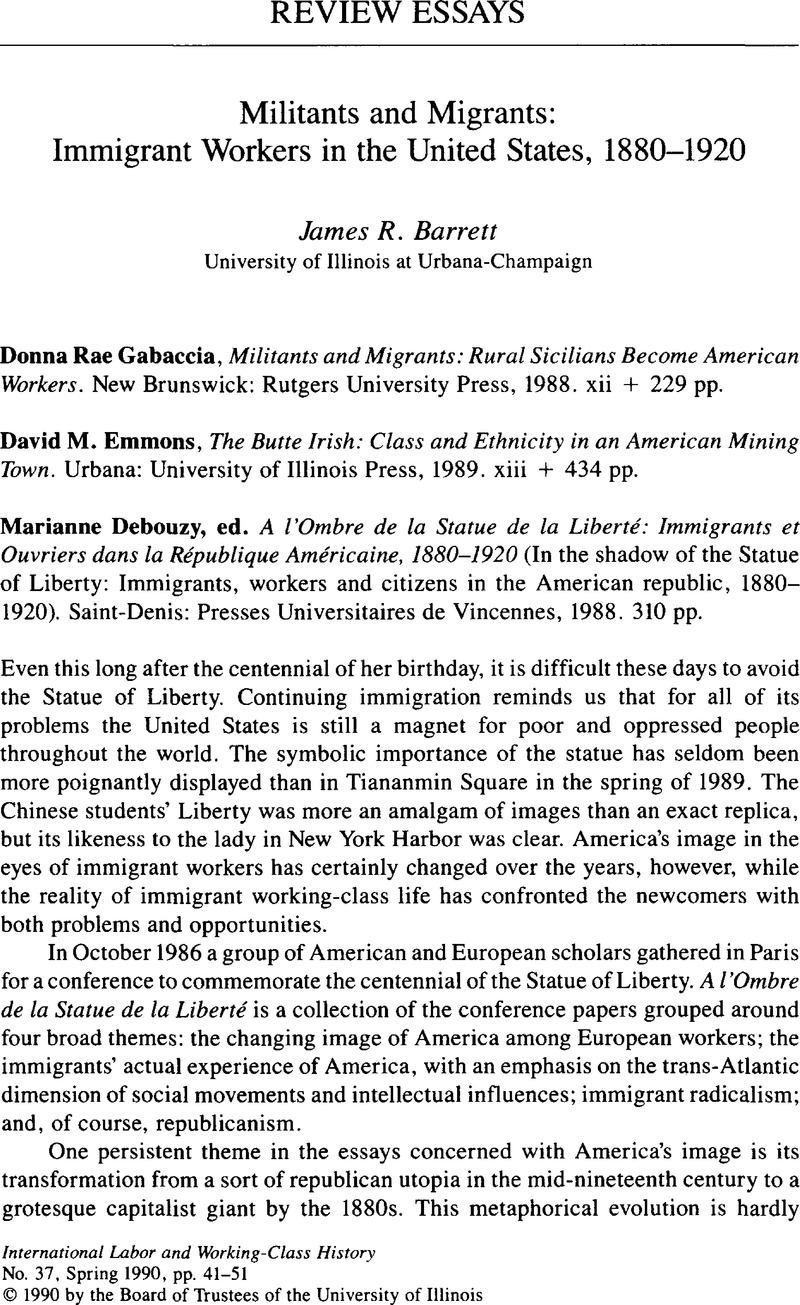No CrossRef data available.
Published online by Cambridge University Press: 16 December 2008

1. Montgomery, David, “Nationalism, American Patriotism, and Class Consciousness among Immigrant Workers in the United States in the Epoch of World War One,” in “Struggle a Hard Battle”: Essays on Working-Class Immigrants, ed. Hoerder, Dirk (DeKalb, Ill., 1986), 327–51Google Scholar; Brody, David, Steelworkers in America, the Nonunion Era (New York, 1969), 218–24.Google Scholar
2. Kula, W., Assorodobraj-Kula, N., and Kula, M., eds., Writing Home: Immigrants in Brazil and the United States, 1890–1891, trans. Wtulich, Josephine (New York, 1986).Google Scholar
3. Walaszek's analysis is more fully developed in Polscy Robotnicy, Praca i Zwiazki Zawodowe W Stanach Zjednoczonych Ameryki, 1880–1920 (Wroclaw, 1988), which includes an English abstract. See also, Waiaszek's “Was the Polish Worker Asleep? Immigrants, Unions, and Workers' Control in America, 1900–1922” and Barrett, James R., “Polish Immigrants and the Mentality of the Unskilled Immigrant Worker, 1900–1922,” Polish-American Studies 46 (1989): 74–96, 100–07.Google Scholar
4. Paul Krause, “Labor Republicanism and Za Chlebom: Anglo-American and Slavic Solidarity at Homestead,” in “Struggle a Hard Battle,” ed. Hoerder, 152–62; Keil, Hartmut, “An Ambivalent Identity: The Attitude of German Socialist Immigrants Toward American Political Institutions and American Citizenship,” in In the Shadow of the Statue of Liberty: Immigrants, Workers and Citizens in the American Republic, 1880–1920, ed. Debouzy, Marianne (Saint Denis, 1988), 247–64.Google Scholar
5. Though hardly cast in these terms, Buenker's, JohnUrban Liberalism and Progressive Reform (New York, 1973)Google Scholar contains considerable evidence of the integration of immigrant working-class voters by both parties through a combination of “bread and butter” reforms and liberal democratic ideology. See also David Montgomery's discussions of early twentieth-century Democratic party strategy in Workers' Control in America: Studies in the History of Work, Technology, and Labor Struggles (Cambridge, 1979), 75–83, and in The Fall of the House of Labor: The Workplace, the State, and American Labor Activism, 1865–1925 (Cambridge, 1987), 356–69.
6. Gutman, Herbert, Work, Culture, and Society in Industrializing America: Essays in Working-Class and Social History (New York, 1976), Ch. 1.Google Scholar
7. Bodnar, John, The Transplanted: A History of Immigrants in Urban America (Bloomington, Ind., 1985).Google Scholar
8. MacDonald, J.S., “Agricultural Organization, Migration and Labor Militancy in Rural Italy,” The Economic History Review 16 (1963): 61–75.CrossRefGoogle Scholar
9. James Larkin was one of a number of World War I-era Irish radicals who argued that the causes of Irish independence and socialism were inseparable. See Larkin, Emmet, James Larkin: Irish Labour Leader (Cambridge, Mass., 1965).Google Scholar
10. The seminal work in this regard, which has influenced Emmons considerably, is that of Bodnar, John. See “Immigration, Kinship, and the Rise of Working-class Realism,” Journal of Social History 14 (1980):45–65CrossRefGoogle Scholar and Workers' World: Kinship, Community, and Protest in an Industrial Society, 1900–1940 (Baltimore, 1982).